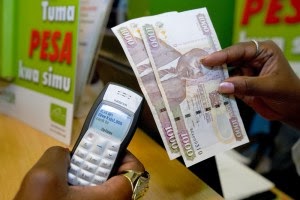Kenyans had close to nothing to do with the creation of M-Pesa that had put the country on the global radar as an innovation hub.
A new book reveals that a senior Vodafone employeeconceived M-Pesa in 2003.
Titled, Money, Real Quick- The story of M-PESA, the book, credits Kenya for the growth of M-Pesa. The mobile money platform has now grown, from a basic money transfer tool to a mobile money facility.
money transfer
A local advertising agency is also credited for coming up with the name M-Pesa that is globally synonymous with money transfer and lately mobile banking.
“While the idea and the technology behind it did germinate in London at Vodafone, the concept was tested, honed and commercialised in Kenya,” reads the book
The book also details how the service has gotten the buy-in of major banks that initially opposed it, and had been pushing Central Bank of Kenya to close it down.
“The bankers created an impression that M-Pesa was a disaster waiting to happen. It was a gamble with people’s money and the government was not being proactive in protecting the public interest.”
The book is co-authored by Tonny Omwansa, a lecturer at the University of Nairobi and Nicholas Sullivan, a Senior Fellow at the Centre for Emerging MarketEnterprises with funding from the Rockefeller Foundation.
M-Pesa was created by Nick Hughes in 2003, then working as the head of social enterprises at Vodafone, which has a 40 per cent stake in Safaricom.
Hughes had in 2003 made a proposal on delivery of financial services over mobile phone. In 2005, he got funding from UK’s Department for International Development to a tune of £1 million (Sh140 million), which was matched by Vodafone in both cash and staff time.
Hughes also worked with local and regional financial services firms in figuring out mostly the needs of unbanked people in East Africa, with initial meetings in Dar Es Salaam.
“To manage the project on the ground, Hughes engaged Susie Lonie, who had a background in mobile commerce with Vodafone in Europe,” reads the book.
“She arrived in Nairobi in 2005, for a three month assignment to run a small scale pilot to improve the efficiency of micro-finance loan repayments.”
COURT BATTLE
A number of Kenyans have in the past claimed to have created M-Pesa, some of them filing lawsuits in a bid to get Safaricom to share earnings.
The service was launched in 2007 with an initial target of getting between 300,000 and 350,000 customers in the first year. The former Safaricom Chief Executive Michael Joseph is quoted as having raised the number of customers that his team was to recruit by more than threefold to over a million.
“I decided that this was going to be big… and I was going to make it big. It thought that if people have M-Pesa, they would not leave Safaricom. They would emotionally bond with Safaricom,” Joseph quoted in the book.
By Macharia Kamau
- The Standard
A new book reveals that a senior Vodafone employeeconceived M-Pesa in 2003.
Titled, Money, Real Quick- The story of M-PESA, the book, credits Kenya for the growth of M-Pesa. The mobile money platform has now grown, from a basic money transfer tool to a mobile money facility.
money transfer
A local advertising agency is also credited for coming up with the name M-Pesa that is globally synonymous with money transfer and lately mobile banking.
“While the idea and the technology behind it did germinate in London at Vodafone, the concept was tested, honed and commercialised in Kenya,” reads the book
The book also details how the service has gotten the buy-in of major banks that initially opposed it, and had been pushing Central Bank of Kenya to close it down.
“The bankers created an impression that M-Pesa was a disaster waiting to happen. It was a gamble with people’s money and the government was not being proactive in protecting the public interest.”
The book is co-authored by Tonny Omwansa, a lecturer at the University of Nairobi and Nicholas Sullivan, a Senior Fellow at the Centre for Emerging MarketEnterprises with funding from the Rockefeller Foundation.
M-Pesa was created by Nick Hughes in 2003, then working as the head of social enterprises at Vodafone, which has a 40 per cent stake in Safaricom.
Hughes had in 2003 made a proposal on delivery of financial services over mobile phone. In 2005, he got funding from UK’s Department for International Development to a tune of £1 million (Sh140 million), which was matched by Vodafone in both cash and staff time.
Hughes also worked with local and regional financial services firms in figuring out mostly the needs of unbanked people in East Africa, with initial meetings in Dar Es Salaam.
“To manage the project on the ground, Hughes engaged Susie Lonie, who had a background in mobile commerce with Vodafone in Europe,” reads the book.
“She arrived in Nairobi in 2005, for a three month assignment to run a small scale pilot to improve the efficiency of micro-finance loan repayments.”
COURT BATTLE
A number of Kenyans have in the past claimed to have created M-Pesa, some of them filing lawsuits in a bid to get Safaricom to share earnings.
The service was launched in 2007 with an initial target of getting between 300,000 and 350,000 customers in the first year. The former Safaricom Chief Executive Michael Joseph is quoted as having raised the number of customers that his team was to recruit by more than threefold to over a million.
“I decided that this was going to be big… and I was going to make it big. It thought that if people have M-Pesa, they would not leave Safaricom. They would emotionally bond with Safaricom,” Joseph quoted in the book.
By Macharia Kamau
- The Standard
Follow @africanewspost











